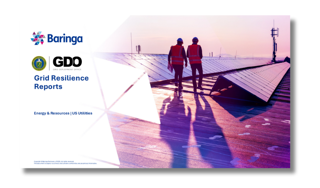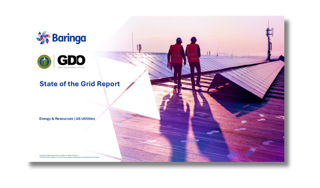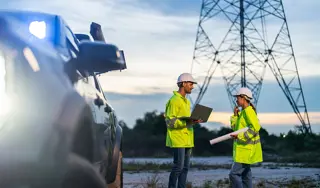
Grid Resilience Analysis and Climate Change Impacts (GRACI)
6 August 2025
As part of the Infrastructure Investment and Jobs Act (IIJA), the federal government has earmarked non-competitive funding for states and Indian tribes to improve the resilience of their electric grids. Known as the Grid Resilience State and Tribal Formula Grants, this program is designed to strengthen and modernize America’s power grid against wildfires, extreme weather, and other natural disasters.
Baringa was commissioned by the Department of Energy (DOE) and the Grid Deployment Office (GDO) to participate in a consortium of technical assistance providers known as Grid Resilience Analysis and Climate Change Impacts (GRACI) as an independent advisor that supported states in the allocation of their grants.
This hub contains all reports and webinars from Baringa’s involvement with 11 states in the Western Electric Coordinating Council (WECC), inclusive of state-specific reports, frameworks, and webinars. These have been made available for public access to share detailed analysis on extreme weather risk and industry best practices for quantifying resilience risk for capital planning.
State-Specific Reports
As part of the GRACI program, Baringa produced a series of custom reports for each state in WECC known as the Grid Resilience Reports (GRR) and the State of the Grid Reports (SOGR). Reports for each of the 11 states can be found below.

Grid Resilience Report
Facilitates the identification of future risks from extreme weather by analyzing downscaled climate projections and assessing the impact to various energy assets out to mid- and end-century. Additionally, the report suggests low- and high-cost mitigation and adaptation strategies to address the identified extreme weather risks.

State of the Grid Report
Assesses the historical importance of particular hazards on county-level outages by establishing a relationship between historical extreme weather and ignitions, extreme outages, and utility spending. The report also evaluates utility capital plans for their alignment, or misalignment, with historical exposure to extreme weather.

Prioritization and Valuation Framework
In the Prioritization & Valuation Webinar, Baringa presents its Asset Resilience framework for forecasting resilience risk in order to inform asset investment valuation and prioritize portfolios. Its purpose is not to prescribe specific adaptation strategies for any jurisdiction or hazard, but rather to give decision makers a framework to evaluate the effectiveness of different investments given a utility’s exposure to specific types of extreme weather.
Webinars
Prioritization and Valuation Webinar
In the Prioritization & Valuation Webinar, Baringa presents its Asset Resilience framework for forecasting resilience risk in order to inform asset investment valuation and prioritize portfolios. Its purpose is not to prescribe specific adaptation strategies for any jurisdiction or hazard, but rather to give decision makers a framework to evaluate the effectiveness of different investments given a utility’s exposure to specific types of extreme weather.
Failure Modes and Adaptation Webinar
In the Failure Modes & Adaptations webinar, Baringa discusses how energy assets fail in the face of extreme weather, stepping through recent examples of major extreme weather events and their impact on energy infrastructure. Furthermore, this webinar covers the importance of modeling the probability of asset failure in better understanding the tradeoffs between investment options.
Contact us
For more information about the GRACI technical assistance program or Baringa’s analytical capabilities, please contact our experts.

Disclaimers
This program is managed by ENERGYWERX in partnership with DOE, a collaboration made possible through an innovative Partnership Intermediary Agreement set up by the DOE's Office of Technology Commercialization. This agreement enables ENERGYWERX to broaden DOE’s engagement with innovative organizations and non-traditional partners, facilitating the rapid development, scaling, and deployment of energy solutions.
State Energy Offices:
This report was prepared as the result of work sponsored by the U.S Department of Energy. It does not necessarily represent the views of the state energy offices, its employees, or the states themselves. The state energy offices, the states, its employees, contractors, and subcontractors make no warranty, express or implied, and assume no legal liability for the information in this report. This report has not been approved or disapproved by the state energy offices, nor have they passed upon the accuracy or adequacy of the information in this report. This report may act as a reference for potential applicants but will not be factored in how grant applications are scored.
Grid Deployment Office:
This material was prepared as an account of work sponsored by an agency of the United States Government. Neither the United States Government nor the United States Department of Energy, nor the Contractor, nor any or their employees, nor any jurisdiction or organization that has cooperated in the development of these materials, makes any warranty, express or implied, or assumes any legal liability or responsibility for the accuracy, completeness, or usefulness or any information, apparatus, product, software, or process disclosed, or represents that its use would not infringe privately owned rights. Reference herein to any specific commercial product, process, or service by trade name, trademark, manufacturer, or otherwise does not necessarily constitute or imply its endorsement, recommendation, or favoring by the United States Government or any agency thereof. The views and opinions of authors expressed herein do not necessarily state or reflect those of the United States Government or any agency thereof.
Is digital and AI delivering what your business needs?
Digital and AI can solve your toughest challenges and elevate your business performance. But success isn’t always straightforward. Where can you unlock opportunity? And what does it take to set the foundation for lasting success?